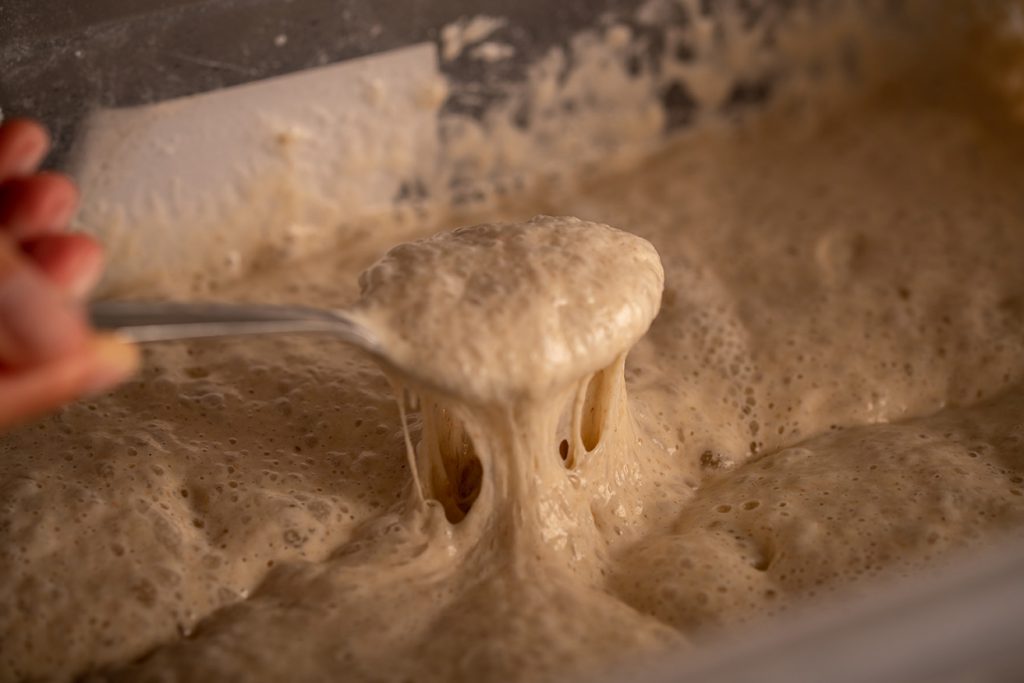If you just started your sourdough journey and have built your own starter from scratch, you have reached the point where you have to take care of it. A few pieces of advice you might want to consider:
- Although it mights seem redundant to say it, it is important. Never ever use the entire starter culture you have for breadmaking, always keep as little as 5-10 grams and feed it. If you use it all, you will have to start all over building your starter from scratch.
- The factors that have an influence on your starter are many, but a few stand out in importance
- Temperature – low temperatures equals slower fermentation. That is why you can keep your starter in the fridge and feed it once a week or every 10 days. However, we don’t recommend refrigerating very young starters, asthey are still not stable. We recommend feeding a young every 12 hours and keeping it at room temperature for at least a month, but the choice is yours.
- Feeding ratios and schedule – the smaller the X in 1:X:X, the hungrier and more acidic your starter will be. We recommend a 1:3:3 ratio for starters to begin with. In time you will be able to tell yourselves what ratios work best for your starter, you might adjust the hydration or schedule to best suit your needs, but if you’re relatively new at the sourdough game, 1:3:3 every 12 hours is a good way to do it.
- The flour you use for feeding. Wholemeal flour and rye flour ferment faster than white bread flour. Depending on the flours you use, you might need to adjust feeding ratios (if you’re using flours that have a high fermentation potential, you will need to increase your feeding ratios, otherwise your starter will ferment in way less than 12 hours and then collapse until the next feeding). We recommend feeding a new starter white bread flour, because it is easy to find, it is very versatile and easy to keep.
- Hydration – The higher the hydration, the more fermentation power your sourdough starter. Also, the stiffer the starter, the more acidic it is. So, if your 100% starter is super active and bubbles up in a few hours you could consider reducing its hydration to say, 70%. That means you will use 70 grams of water per 100 grams of flour for each feeding.
- You have to get used to discarding starter. Yes, that means throwing it away and we know it’s a difficult thought to accept as everyone is trying to reduce waste, but it’s necessary. However, once your starter is mature enough and you have enough know how about it, you can definitely keep it refrigerated and take it out only when you will use it, thus significantly reducing waste, but if you’re new at this don’t skimp. You will be tempted to keep more starter for each feeding, after all what’s the big deal? The big deal is that if you keep a very high ratio of starter for each feeding, your starter will always be hungry. Hungry equals acidic equals not powerful enough equals wasting a lot more flour and time for unsatisfactory breads. So you will waste more trying to reduce waste. Trust the process.
- Your first sourdough loaves might be very sour or not rise enough or have a number of other issues. That can be due to your starter, if it’s very young it can be pretty unpredictable both in terms of proofing power and in terms of taste. However, as you progress, you will see your starter changing and improving week after week, it will become stronger, have a better smell and taste and be a lot more predictable.
How to back up your starter
We can’t emphasize the importance of having at least one back-up for your sourdough starter. Accidents do happen, kids and cats do spill over jars, people turn on the oven and forget to check if there’s something inside, so it’s always a good idea to have something to turn to if (or rather when) that happens.
You can do this two ways:
- Have a small jar of starter (10 grams is enough) in the freezer. If you keep it in the freezer, make sure to thaw it in the fridge for at least 24 hours and make sure it is active before feeding it. If you simply remove your backup from the freezer and feed it immediately after thawing, the beasties inside won’t have time to wake up and start fermenting until you feed it.
- Keep a small amount of freshly fed starter in the fridge. However, if you keep it in the fridge, you will still need to feed it, but only every 7-10 days.
- You can dry up starter – simply smudge up some starter (you will do this once your starter is ripe, not right after it’s been fed) in a thin layer on a baking sheet. Let it dry out for about 24 hours, then simply scrape it off and keep it in a jar or a zip lock bag in a cabinet away from heat and moisture sources. To reactivate it, you will need to tear down the starter chips in a mortar, hydrate them by adding water and wait until the water foams a little. Then you can add the same amount of flour as you did water and wait for 8-12 hours until the culture is up and running.
From that point onward, you can maintain your culture as a regular starter – “How to maintain a sourdough culture”.
Happy baking!

